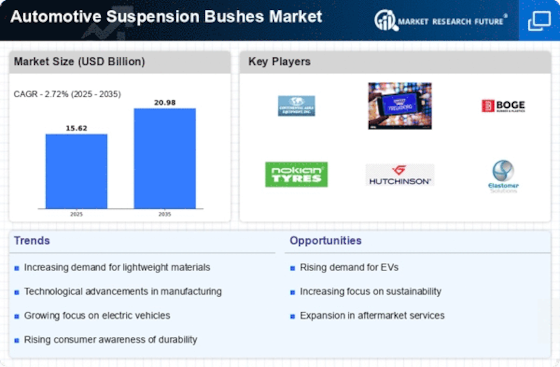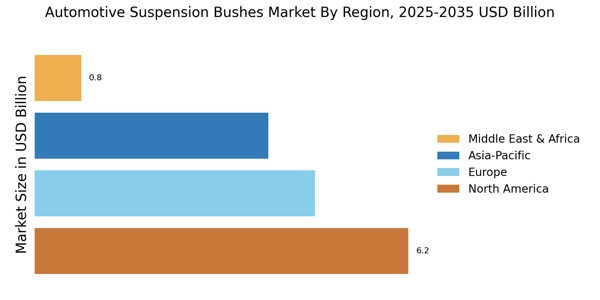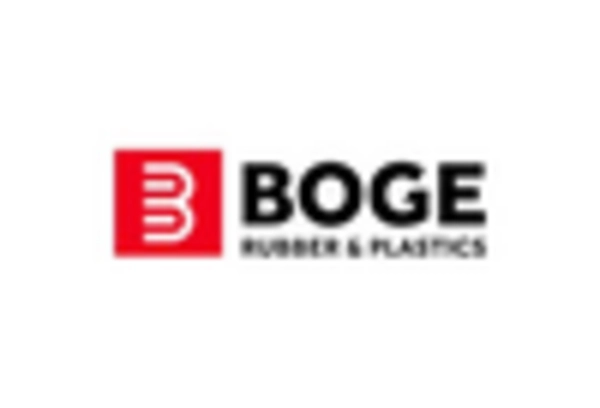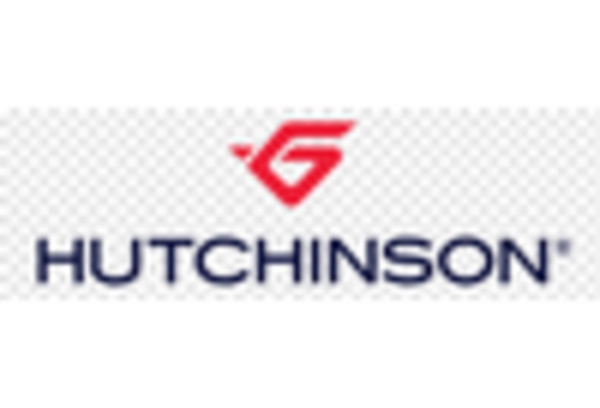Rising Aftermarket Demand
The automotive suspension bushes market is witnessing a rise in aftermarket demand, driven by the increasing number of vehicles on the road and the need for maintenance and replacement parts. As vehicles age, the wear and tear on suspension components necessitate the replacement of bushes to ensure optimal performance and safety. In 2025, the automotive aftermarket is expected to reach a valuation of over 400 billion USD, highlighting the potential for growth within the suspension bushes segment. This trend is further supported by the growing awareness among consumers regarding the importance of regular vehicle maintenance, which is likely to bolster the automotive suspension bushes market as more vehicle owners seek to replace worn-out components.
Increasing Vehicle Production
The automotive suspension bushes market is experiencing growth due to the rising production of vehicles worldwide. As manufacturers ramp up production to meet consumer demand, the need for high-quality suspension components, including bushes, becomes paramount. In 2025, the total vehicle production is projected to reach approximately 90 million units, indicating a robust demand for automotive parts. This surge in vehicle production is likely to drive the automotive suspension bushes market, as these components are essential for ensuring vehicle stability and comfort. Furthermore, the increasing trend of electric vehicle production is expected to contribute to this growth, as these vehicles require specialized suspension systems to accommodate their unique weight distribution and performance characteristics.
Regulatory Standards and Compliance
Regulatory standards and compliance are increasingly shaping the automotive suspension bushes market. Governments worldwide are implementing stringent regulations regarding vehicle safety and emissions, which directly impact the design and manufacturing of suspension systems. As a result, manufacturers are required to produce suspension bushes that not only meet performance criteria but also adhere to environmental standards. This regulatory landscape is expected to drive innovation within the automotive suspension bushes market, as companies strive to develop materials and designs that comply with these regulations. In 2025, the market for compliant automotive components is projected to grow, reflecting the industry's adaptation to these evolving standards and the consequent demand for high-quality suspension bushes.
Growing Demand for Vehicle Comfort and Safety
The automotive suspension bushes market is being driven by the growing consumer demand for enhanced vehicle comfort and safety. As consumers become more discerning about their driving experience, manufacturers are compelled to invest in better suspension systems that utilize high-quality bushes. These components play a crucial role in minimizing vibrations and noise, thereby improving ride quality. In 2025, it is estimated that the market for automotive comfort features will reach approximately 25 billion USD, indicating a strong correlation between consumer preferences and the demand for advanced suspension components. Consequently, the automotive suspension bushes market is likely to benefit from this trend, as manufacturers seek to meet the evolving expectations of consumers.
Technological Advancements in Suspension Systems
Technological advancements in suspension systems are significantly influencing the automotive suspension bushes market. Innovations such as adaptive suspension systems and electronically controlled dampers are becoming more prevalent, necessitating the use of advanced suspension bushes that can withstand varying loads and conditions. The integration of these technologies is expected to enhance vehicle performance, safety, and comfort, thereby increasing the demand for specialized suspension components. In 2025, the market for advanced suspension systems is anticipated to grow at a compound annual growth rate of around 6%, further propelling the automotive suspension bushes market. As manufacturers invest in research and development to create more efficient and durable suspension systems, the need for high-quality bushes will likely rise.


















Leave a Comment